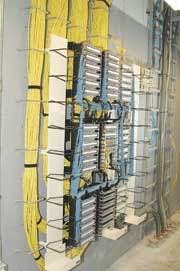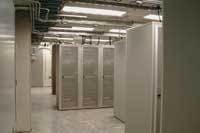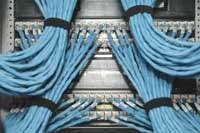NASA’s 190,000-square-foot Operations Support Building II defies the notion that “it’s not rocket science.”
When the National Aeronautics and Space Administration (NASA; www.nasa.gov) decided to upgrade the communications network in its Operations Support Building II at the Kennedy Space Center (KSC) in Merritt Island, FL, performance, reliability, and price ranked high on the list of selection criteria.
The five-story, 190,000-square-foot building designed by the architectural and engineering firm of Wolfberg Alvarez & Partners (www.wolfbergalvarez.com), houses training facilities and operations for 960 engineers and other professionals who play a crucial role in NASA’s space program and the shuttle launches at KSC. The communications network is essential to NASA’s missions, and a robust structured cabling infrastructure is critical to the reliable performance of their network.
NASA awarded the contract for the communications upgrade to Olson Electric Company Inc. (www.olsonelectric.net) of Sanford, FL, a design and installation firm serving commercial, industrial, and defense clients in the southeastern U.S. For the cabling products, Olson turned to Belden CDT Networking, selecting the Belden IBDN System 10GX, a 10GBase-T-ready horizontal cabling system.
Designed for the future
According to Andrew Spencer, Olson Electric’s vice president and general manager, NASA’s goal for the upgrade was to migrate to a high-performance integrated communications system-either Category 5e or Category 6. The system had to be capable of supporting all current voice, data, and broadband video functions, and offer sufficient headroom to accommodate additional data-intensive applications in the years ahead.
When the project was originally bid, the planned horizontal infrastructure was Category 5e, with multimode fiber to the desktop. But a change in NASA standards drove the move to a 10-Gbit copper solution.
“When the change was implemented, we proposed Belden IBDN based on technology, price, and delivery,” said Spencer, the project manager for NASA’s communications system implementation. In early 2005, Belden CDT Networking introduced the System 10GX, an unshielded twisted-pair solution designed to support 10-Gbit Ethernet. The manufacturer backs its system with a guarantee of reliable performance up to 625 MHz. After careful evaluation and testing of the products in the presence of NASA’s selection team, Olsen Electric verified the cabling system’s performance to 625 MHz and NASA approved the proposed installation.
Cabling the site
According to installers at NASA’s Operations Support Building II, the 10GX cables are run through cable trays configured in a star topology to the offices on each floor, where the majority of workstations are equipped with special faceplates and three 10GX cables-two for data and one for voice. The 10GX cables are also used to support broadband and video applications on the building’s fifth floor.
The main telecommunications room (TR), located on the first floor, houses 2,400 incoming copper pairs as well as 288 incoming fiber strands from an installed fiber-optic backbone in which Belden IBDN FiberExpress panels and connectors are used. Belden IBDN’s GigaBIX hardware is installed in the main TR and in each floor’s telecom room to provide space-saving voice terminations and cross-connects.
Anatomy of a 10-Gig-ready system
According to Belden CDT Networking, the 10GX end-to-end UTP system was designed and engineered specifically to meet the high-speed, high-bandwidth needs of 10GBase-T networks. It incorporates a series of patent-pending enabling technologies involving the cable design as well as the design of the modular cords, patch panels, and modules.
These enabling technologies, the company claims, make it possible to dramatically improve near-end crosstalk, alien near-end crosstalk, and impedance over traditional technologies, and are why the manufacturer guarantees channel performance to a minimum value of 625 MHz.
The insulation-displacement connection (IDC) is one of the most sensitive areas for alien crosstalk management. Traditionally, all of the IDC contacts align in such a way that makes them antennas, allowing adjacent copper pairs to both emit and receive noise. So, one of the major technological challenges in designing an effective 10-Gbit system is that the level of alien crosstalk must be 15 dB (30 times) lower than the alien crosstalk for 1000Base-T at 100 meters.
Construction of Belden CDT Networking’s System 10GX features an IDC design and patch panel circuit layout called MatriX IDC technology. This design positions each IDC at a 90° angle to its neighbor, which effectively cancels out the alien crosstalk between modules by 15 dB over traditional patch panel constructions.
Belden CDT Networking offers this technology in its 10GX 48-port 1U Ultra High-Density patch panel. Many traditional 48-port patch panels require two units of rack space (2U); the Belden CDT Networking product fits 48 ports into 1U. When used with the system’s 0U patch-cord management system, the 10GX 1U Ultra High-Density patch panel provides four times the density of standard patch panels.
Copper’s economic advantages
Because the system is copper based, it offers economies in new installations and provides a cost-effective migration path from existing 100Base-T and 1000Base-T cable plants. Because of these economies, the system typically is able to meet users’ pricing requirements and reduce total cost of ownership while meeting demanding performance objectives and protecting the customer’s technology investment. The manufacturer also offers a 25-year product warranty and lifetime application assurance when the system is installed by one of its certified system vendors.
As NASA’s installation of the Belden IBDN System 10GX neared completion late last year, with all horizontal links installed, Olson Electric and Belden IBDN performed testing on 4,000 drops. According to Olson Electric’s Spencer, all performed without a single failure.
“The NASA project, which is the largest 10-Gigabit system to be installed at the Kennedy Space Center, has been very successful, and our customer has expressed a high degree of satisfaction with both the communications system we installed and the professionalism of the work performed,” Spencer says.PAUL KISH is director of Belden IBDN systems and standards for Belden CDT Networking (www.beldencdt.com).





